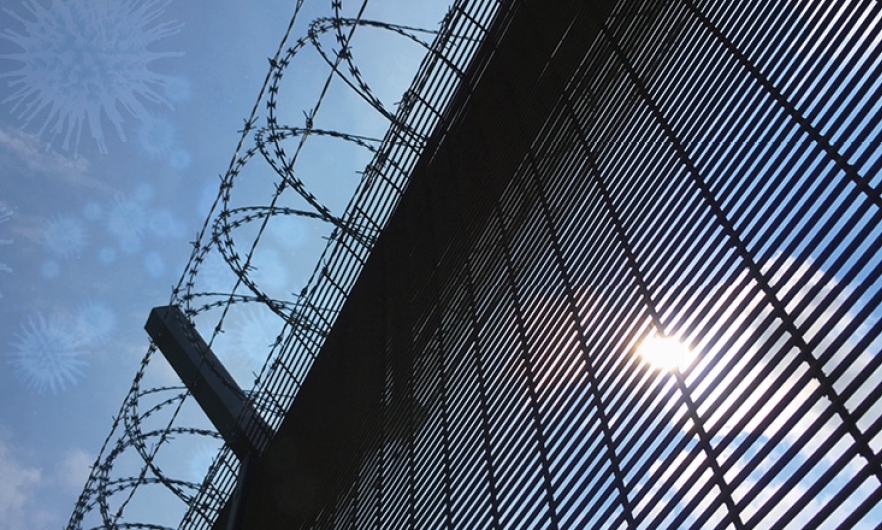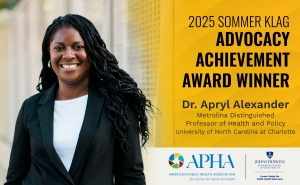COVID-19 in Jails, Prisons, and Immigration Detention Centers: A Q&A with Chris Beyrer

Successes and setbacks in protecting incarcerated people and those who care for them from COVID-19
INTERVIEW BY STEPHANIE DESMON
From the first warnings about COVID-19, Chris Beyrer, MD, Desmond M. Tutu Professor of Public Health and Human Rights, flagged the potential for catastrophic outbreaks in America’s packed jails, prisons, and immigration detention centers.
In April, Beyrer spoke with Stephanie Desmon about the impossibility of social distancing in these congregate settings, and the low-risk/high-reward strategy of releasing those held on administrative misdemeanors.
Several months later, Beyrer returned to the podcast to give an update on outbreaks among incarcerated people and those who care for them. In this Q&A with Stephanie Desmon of the Johns Hopkins Center for Communication Programs, Beyrer, an epidemiologist, talks about grim statistics, some victories with decarceration and the release of high-risk individuals, and what still needs to be done.
Stephanie Desmon: We spoke several months ago about COVID-19 in jails, prisons, and detention centers. We were very worried at the time that this would become a real problem, and I think what you're about to tell me is that you were right.
Chris Beyrer: You never want to be proven right by human suffering. However, that is what we’re seeing.
As an epidemiologist who has done research on infectious diseases in prisons, I knew right away that this was going to be a real problem. When we talked some months ago, [prisons and jails] were among the first big outbreaks in Wuhan, China. So we knew that was an issue. Indoor facilities, crowded population density, and hygiene challenges make prisons, jails, and detention centers particularly vulnerable to infectious viruses and certainly to this virus.
So, we were ringing the alarm bells. We were trying to encourage decarceration to reduce overcrowding; to get people out of jails, for example, who had only unpaid fines or other forms of administrative detention. But, largely, the response was too slow with too few releases.
Now we have an enormous number of outbreaks in prisons—state and federal prisons and jails—with close to 50,000* people in federal and state prisons who have tested positive, a large number of deaths, and more than 10,000* staff in federal and state prisons who have acquired COVID-19. Some of those people have been infected in their communities but, of course, many of them through their work in prisons and jails. So it’s been extremely frustrating.
But we have had some victories, too.
[Compared to the] roughly 2.3 million people in prison and jails, there are only about 35,000 to 40,000 people in immigration detention under the Immigration and Customs Enforcement, or ICE.
In the past, the majority of these people would never have been detained. It’s only been in this administration that we have made a policy of detaining people while they are awaiting, for example, their hearings on asylum.
We were approached by a group of lawyers working with clients who were in detention centers on an ICE facility in El Paso, Texas. The petitioners were five older Latina women who had, in addition to their age, at least one—if not more—preexisting conditions like diabetes and hypertension that would have predisposed them to becoming severely ill if they did get COVID. And they were in a very crowded detention facility.
These facilities were never prepared to handle a pandemic. There are typically up to about 80 people segregated by gender—in this case, about 80 women—in one of these holding areas sharing crowded common space—shared bathrooms and eating areas—with limitations on soap and hand washing, and on the ability to do the required social distancing.
We asked, Is it possible that these women can be protected from COVID-19 if there is transmission in this facility? And, if not, would they be likely to have a more serious complication or even death? We worked with the lawyers to review all of the evidence. They sent us detailed plans of the facility and housing arrangements, and we determined that ICE could not protect these women, and that they would be at high risk if they got exposed.
That case went to a federal judge. He agreed and ordered all five women released. They all had family in the U.S., so they all got to go home. But, more importantly, in his ruling he cited our scientific evidence and said that ICE had failed to prove that they could protect these women from exposure. That’s a very important federal precedent, because that applies, of course, to multiple facilities.
SD: What about the ongoing threat in jails, which seems to have been made worse by protests where people are getting arrested?
CB: There was an important study out of Cook County in Chicago where there was a serious outbreak in prisons and jails. That [study] suggested that a significant [number] of cases in the surrounding community—up to about 25%—were attributable to transmission from the jail and from people cycling through the jail.
Prison, federal, and state penitentiaries are where people are generally housed after they have a felony conviction. Jails, which are run by counties and cities, are typically housing people who are awaiting sentencing or a trial, or who are detained for a short period of time. There are a lot more people cycling in and out. That, of course, is a risk for COVID.
There have been a large number of protests against police brutality, racial inequality, and structural racism in every state in this country. And some have been met with restraint and some have been met, as we know, with large numbers of arrests and detentions. There was a situation in New York where many hundreds of demonstrators were held up to 24 hours or longer in crowded detention cells. And all they were waiting for is a ticket and to get their court date for a hearing. So those people, if they should be arrested at all, should have been there for an hour. That would dramatically reduce [the risks of] COVID exposure.
And the [risk is] not just in the jail itself. People were loaded onto crowded buses from protests. They had to go through processing when they got there. All of that has to be done with appropriate social distancing and hygiene, [but] it's very hard to stay six feet away from people when you are being arrested, handcuffed, and forced into a bus. So that is a real concern.
The idea of detaining people and putting them in a crowded jail cell while awaiting what are essentially administrative procedures is totally unacceptable from a public health perspective in the time of COVID.
SD: Some people in detention centers have been allowed to go home early because of COVID. Others are still being sent to prison. Should we be keeping nonviolent folks home for now?
CB: Absolutely.
We’re concerned about all of the people. We’re concerned about the guards, the staff. A very significant proportion of the people who work in prisons are contract hires and low-income workers who are also being exposed. We’re also concerned about their families and other people that they live with. This affects a much wider group of people than just those who are detained.
We’re still not doing anywhere near enough testing to keep people safe. But what we’re very concerned about is that where there has been comprehensive testing, the numbers have been extraordinarily high. The first prison to do this was in Marion, Ohio, and more than 70% of the detainees and staff were already COVID positive.
At the beginning of the pandemic, we were so worried about nursing homes and long-term care facilities—which are also closed crowded places, but with a very vulnerable group of patients. But now, more than five of the 10 biggest clusters of COVID cases in the U.S. are in prisons and jails.* We are still calling on public health grounds for decarceration—reducing the number of people detained.
There have been some important wins. In our local community, for example, the state's attorney for Baltimore, Marilyn Mosby, early on made the announcement that Baltimore would not be jailing people for administrative fees and fines and other things in an effort to avoid the overcrowding in the facilities. That has happened in a number of municipalities, and it’s very encouraging.
But it’s been a much harder situation for people who are already inside. Even when, for example, Governor Hogan ordered the release of 800 prisoners, it’s not entirely clear how many of them were [actually] released. The parole boards are not meeting and courts are not open in many municipalities. It’s very frustratingly slow. And of course, COVID-19 is anything but slow.
SD: What about the case in New York involving a death row inmate?
CB: This is an extraordinary situation. In this particular case, the incarcerated person is in federal prison in Indiana; but his lawyer is in New York, and she is an older person who also has underlying health conditions.
His laywer reached out to us to weigh in on the safety and the provisions for herself, her legal team, for this man, and for his family to come to the facility and see him. The government set his date of execution for mid-July. And it turns out that there is COVID in the prison. There is COVID in the community around this prison. It’s in a state with rising rates of infection.
Not only do people have to get in and out of the prison to see him, they also have to get in and out of the state and, in the case of the lawyer, they have to fly there, so they would be in and out of airports. This immediately raises the question: Is it safe?
Our determination was no, it is not, and that the execution should be stayed until it’s safe for this man to say goodbye to his family and to see his lawyers and representatives. And that these things shouldn’t happen before there is COVID-19 control achieved. The lawyers asked for [a stay until the] middle of 2021. We'll see how that goes.
The whole idea of the government deciding to ramp up executions in the time of a pandemic seems like an extraordinary waste of human energy and talent. We have an epidemic to fight. That’s what we all ought to be concentrating on, particularly the Justice Department, because these are people under their administrative control.
*As of July 2020
Stephanie Desmon is the co-host of the Public Health on Call podcast. She is the director of public relations and marketing for the Johns Hopkins Center for Communication Programs, the largest center at the Bloomberg School of Public Health.
Public Health On Call
This conversation is excerpted from the July 22 episode of Public Health On Call.





